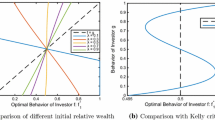Abstract
The aim of this paper is to test the performance of capital asset pricing model (CAPM) in an evolutionary framework. We model an economy where a heterogeneous population of long-lived agents invest their wealth according to different portfolio rules, and prove that traders who either “believe” in CAPM and use it as a rule of thumb, or are endowed with genuine mean-variance preferences, under some very weak conditions, vanish in the long run.We show that a sufficient condition to drive CAPM or mean-variance traders’ wealth shares to zero is that an investor endowed with a logarithmic utility function enters the market.
Similar content being viewed by others
Reference
Algoet P.H., Cover T.M. (1988) Asymptotic optimality and asymptotic equipartition properties of log-optimum investment. Ann Prob 16: 876–898
Biais B., Shadur R. (2000). Darwinian selection does not eliminate irrational traders. Eur Econ Rev 44: 469–490
Blume L.E., Easley D. (1992) Evolution and market behaviour. J Econ Theory 58: 9–40
Blume, L.E., Easley, D.: If you’re so smart, why aren’t you rich? belief selection in complete and incomplete markets. Econometrica (forthcoming) (2005)
Breiman, L.: Optimal gambling systems for favorable games. In: Proceedings of the 4 berkeley symposium. University of California Press 1961
Caldarelli, G., Piccioni, M., Sciubba, E.: A numerical study on the evolution of portfolio rules. In: Chen, S.H. (ed) Genetic algorithms and genetic programming in computational finance. Kluwer, Boston (2002)
Cooper W.S., Kaplan R.H. (1982) Adaptive ‘Coin-Flipping’: a decision-theoretic examination of natural selection for random individual variation. J Theor Biol 94: 135–151
Coury T., Sciubba E. (2005) Belief heterogeneity and survival in incomplete markets. University of Oxford, Mimeo
De Long J.B., Shleifer A., Summers L.H., Waldmann R.J. (1990). Noise trader risk in financial markets. J Political Econ 98: 703–738
De Long J.B., Shleifer A., Summers L.H., Waldmann R.J. (1991). The survival of noise traders in financial markets. J Business 64: 1–19
Fama E.F., French K.R.(1996). Multifactor explanations of asset pricing anomalies. J Finance 51: 55–84
Fama F., French K.R. (1996) The CAPM is wanted, dead or alive. J Finance 51: 1947–1958
Finkelstein M., Whitley R. (1981) Optimal strategies for repeated games. Adv Appl Prob 13: 415–428
Goldman M.B.(1974) A negative report on the ‘Near Optimality’ of the max-expected-log policy as applied to bounded utilities for long lived programs. J Financial Econ 1: 97–103
Guidolin, M.: High equity premia and crash fears. Rational Foundations. Economic Theory (forthcoming) (2005)
Hakansson N.H. (1971) Multi-period mean-variance analysis: toward a general theory of portfolio choice. J Finance 26: 857–884
Hens T., Schenk-Hoppé K. (2005). Evolutionary stability of porfolio rules in incomplete markets. J Math Econ 41: 43–66
Jagannathan R., Wang Z. (1996) The conditional CAPM and the cross-sections of expected returns. J Finance 51: 3–53
Kelly J.L. (1956) A new interpretation of information rate. Bell Syst Tech J 35: 917–926
Kyle A.S., Wang F.A. (1997) Speculation duopoly with agreement to disagree: can overconfidence survive the market test?. J Finance 5: 2073–2090
Kurz M., Motolese M. (2001). Endogenous uncertainty and market volatility. Econo Theory 17: 497–544
Latane H.A.(1959). Criteria of choice among risky ventures. J Political Econo 67: 144–155
Lintner J. (1965) The valuation of risk assets and the selection of risky investments in stock portfolios and capital budgets. Review of Economics and Statistics 43: 13–37
Luenberger D.G. (1993). A preference foundation for log mean-variance criteria in portfolio choice problems. Journal of Economic Dynamics and Control 17: 887–906
Mailath G.J., Sandroni A. (2003) Market selection and asymmetric information. Review of Economic Studies 70: 343–368
Merton R.C., Samuelson P.A.(1974). Fallacy of the log-normal approximation to optimal portfolio decision-making over many periods. Journal of Financial Economics 1: 67–94
Mossin J. (1966) Equilibrium in a capital asset market. Econometrica 34:768–783
Mossin J. (1968). Optimal multiperiod portfolio policies. Journal of Business 41: 215–229
Pástor L. (2000). Portfolio selection and asset pricing models. Journal of Finance 55: 179–223
Sandroni A. (2000). Do markets favour agents able to make accurate predictions?. Econometrica 68: 1303–1341
Sciubba, E.: The evolution of portfolio rules and the capital asset pricing model. University of Cambridge DAE Working Paper 9909 (1999)
Sciubba E. (2005) Asymmetric information and survival in financial markets. Economic Theory 25: 353–379
Sharpe W.F.(1964). Capital asset prices: a theory of market equilibrium under conditions of risk. Journal of Finance 19: 425–442
Author information
Authors and Affiliations
Corresponding author
Rights and permissions
About this article
Cite this article
Sciubba, E. The evolution of portfolio rules and the capital asset pricing model. Economic Theory 29, 123–150 (2006). https://doi.org/10.1007/s00199-005-0013-2
Received:
Accepted:
Published:
Issue Date:
DOI: https://doi.org/10.1007/s00199-005-0013-2



